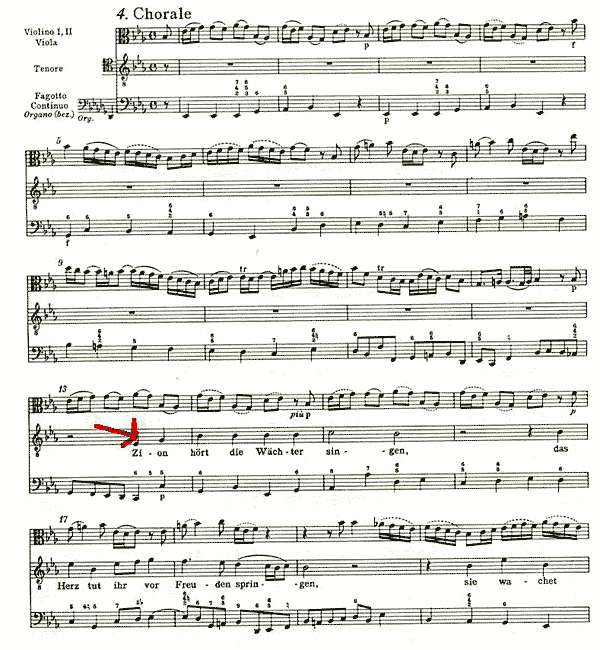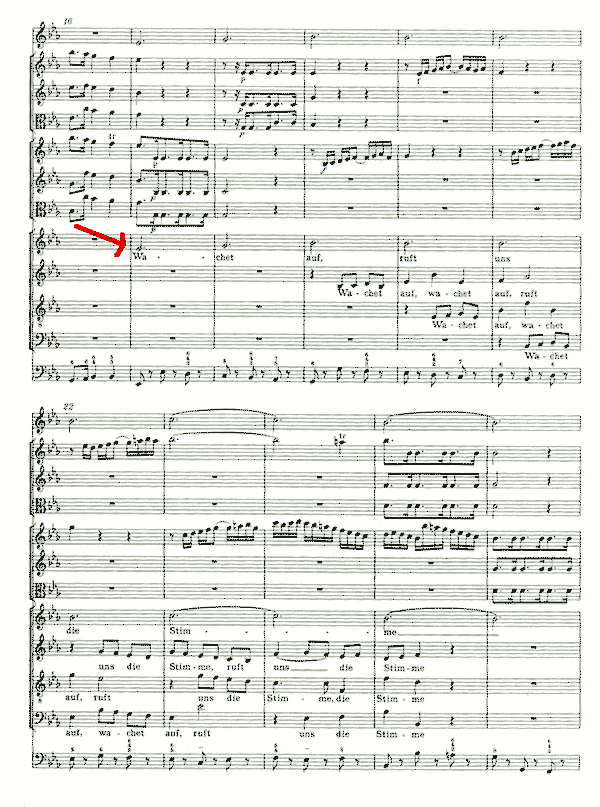This cantata was written for the 27th Sunday after Trinity, which is the last Sunday in the Church Year. This means that a performance of this cantata should occur immediately before Advent, the four-week period of repentance and preparation anticipating Christmas. But this particular feast, the 27th Sunday after Trinity, is a rare occurrence, since it can only happen when the preceding Easter comes early in the year. Knowing this, and knowing that this feast only occurred twice during Bach’s time in Leipzig, we can deduce that Cantata 140 was written in 1731.
Cantata 140 is one of Bach’s most famous and best-loved works. It is a chorale cantata and uses a very famous chorale, “Wachet auf”, which appears in many Christian hymnals. Like the chorale heard in Cantata 1, this chorale was written by Philipp Nicolai. There is a very sad story attached to this particular chorale. (The same story, in fact, applies to the chorale which is used in Cantata 1, “Wie schön leuchtet der Morgenstern.”) Here’s the story:
Once upon a time, in the late 16th century, a terrible plague spread through parts of Europe, including a town in Germany called Unna. Approximately 1300 residents of Unna died during this outbreak. Philipp Nicolai (1556-1608) was the pastor of a church in this town. He, too, became ill, and figured he was also going to die. While he was lying around anticipating his death, he recorded his mediations in a journal. When to his surprise he recovered from his illness, he wrote two hymns (“Wachet auf” and “Wie schön leuchtet der Morgenstern”) and attached them to the journal he kept during the plague. Both hymns have now achieved immortality as a result.
The famous chorale “Wachet auf” is used in three of the seven movements in Cantata 140. Let’s look at each of those three movements, beginning with the last.
Very often, Bach concludes his chorale cantatas with a simple, straightforward, homophonic setting of the chorale. This way, the congregation can join in the singing as his composition concludes. In this hymn-like version, the soprano voices and instruments in the orchestra (violins, oboes; any instrument that can play high parts) play or sing the melody, and the other voices an instruments fill in the harmonies. Here is what the first page of this movement looks like:

The middle movement is also a chorale, and is one of Bach’s most famous pieces. This time, only one part, the tenors, sing the chorale tune. The strings in the orchestra join together to play an active counter melody (a secondary tune, almost equal in importance to the main melody sung by the tenors, and occurring simultaneously). The beginning of this movement is shown below. Notice how the tenors clearly have the chorale tune:

Another movement that employs the chorale is the first movement. This is the most complicated. It is a chorale fantasy, common to many opening movements of Bach’s chorale cantatas. It begins with a dignified, stately orchestral introduction, which takes the place of a prelude. The introduction is marked initially by dotted rhythms to give the stately feel. This same passage serves as an interlude between statements of the opening section of the chorale. The chorale later enters (in measure 17) in long tones in the sopranos, while the lower voices enhance and ornament the texture.



































